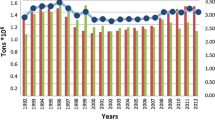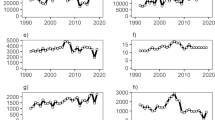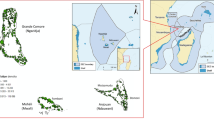Abstract
The Japanese type of set-net, Otoshi-ami, was introduced to Thailand in 2003 with the aim of assessing its feasibility as a sustainable coastal fisheries management tool for the empowerment of coastal fishers’ communities. All preparations for constructing and installing the set-net in the coastal waters off Mae Rumpheung beach, Rayong Province, Thailand, were carried out by local fishers, with technical advice and support from national and international institutions. The gear was modified and developed to suit the conditions of the fishing ground and target species. Data on the catch and sales trends in Rayong using the set-net were collected for 7 years for statistical analysis; during this period, the gear design and marketing strategies were improved. Simulation analysis for evaluating the cost–profit bases was conducted to establish a model for set-net technology transfer in Southeast Asia, based on differing numbers of fishers and operation days. The simulation results show the required size of the average daily catch to cover the total cost according to the average unit price, where the economic return point is an average catch of 128 kg, based on a unit price of 25 Baht/kg (0.83 USD/kg), with ten fishermen and a daily operation cost of 3,200 Baht (USD 106.17).






Similar content being viewed by others
References
Gabriel O, Lange K, Dahm E, Wendt T (2007) Fish catching methods of the world, 4th edn. Blackwell, London
Akiyama S (2010) Teichi-ami. In: Takeuchi T et al (eds) A handbook on fisheries science (in Japanese). Seibutsu Kenkyusha, Tokyo, pp 256–258
He P, Inoue Y (2010) Large-scale fish traps: gear design, fish behavior, and conservation challenges. In: He P (ed) Behavior of marine fishes: capture processes and conservation challenges. Blackwell, Singapore, pp 159–181
Story GM, Kirwin WJ, Widdowson JDA (1990) Dictionary of Newfoundland English, 2nd edn. University of Toronto Press, Toronto
Siira A, Suuronen P, Kauppinen Ikonen E, Erkinaro J (2006) Survival of Atlantic salmon captured in and released from a commercial trap-net: potential for selective harvesting of stocked salmon. Fish Res 80:280–294
Suuronen P, Siira A, Kauppinen T, Riikonen R, Lehtonen E, Harjunpaa H (2006) Reduction of seal-induced catch and gear damage by modification of trap-net design: design principles for a seal-safe trap-net. Fish Res 79:129–138
Ravier C, Fromentin J-M (2001) Long-term fluctuations in the Eastern Atlantic and Mediterranean bluefin tuna population. ICES J Mar Sci 58:1299–1317
Wardle CS, Videler JJ, Arimoto T, Franco JM, He P (1989) The muscle twitch and the maximum swimming speed of giant bluefin tuna, Thunnus thynnus L. J Fish Biol 35:129–137
Bridger JP, Foster JJ, Margetts AR, Strange ES (1981) Glossary of United Kingdom fishing gear terms. Fishing News Books, Farnham
Reid GK Jr (1955) The pound-net fishery in Virginia. Part 1. History, gear description and catch. J Commer Fish Rev 17:1–15
Hubert WA (1983) Passive capture techniques. In: Nielsen LA, Johnson DL (eds) Fisheries techniques. Southern Printing, Blacksburg, pp 95–122
Yun IB, Lee JH, Kwon BG, Cho YB, Yoo JB, Kim SH, Kim BY (2004) A study on improvement for fishing gear and method of the Pound-net-I-Net shapes of the commercial net in the flow. Bull Korean Soc Fish Tech 40(4):268–281
Training Department (2008) Set-net fishing technology transfer for sustainable coastal fisheries management in Southeast Asia. Report TD/RES/107. Southeast Asian Fisheries Development Center, Phrasamutchedi, pp 1–214
Fisheries and Fishing Port Division (2003) Report on the set net training program in Himi. Fisheries and Fishing Port Division, Himi, pp 1–117
SEAFDEC/TD and DOF Thailand (2005) Final report of set-net project/Japanese trust fund I: introduction of set-net fishing to develop the sustainable fisheries management in Southeast Asia: case study in Thailand 2003–2005. Report TD/RP/74. SEAFDEC/TD and DOF Thailand, Phrasamutchedi, pp 1–402
Nomura M (1980) Influence of fish behavior on use and design of setnets. In: Bardach JE et al (eds) Fish behaviour and its use in the capture and culture of fishes: ICLARM Conference Proceedings 5, International Center for Living Aquatic Resources Management, Manila, pp 446–471
Akiyama S, Arimoto T (2001) Set-net—capture process research and prospects for the development of selective fishing gear and techniques (in Japanese). Nippon Suisan Gakkaishi 67:134–135
Akiyama S, Arimoto T (2000) Analysis of accumulation performance of differing set-net designs. Fish Sci 66:78–83
Munprasit A, Amornpiyakrit T, Yasook N, Yingyuad W, Manajit N, Arimoto T (2005) Fishing methods and catch composition of stationary fishing gear in Thailand (in Japanese with English abstract). In: Proc Steering Committee for the Colloquium on Fishing Technology. Jap Soc Fish Sci 50:34–35
Acknowledgments
The authors would like to thank the participants of the Rayong set-net fishers group for their full engagement and cooperation in the set-net operation and management. We also express our sincere gratitude to the participating institutes for their support in both the practical and theoretical aspects of set-net technology transfer: Eastern Marine Fisheries Research and Development Center (EMDEC); Department of Fisheries, Thailand, and Training Department of Southeast Asian Fisheries Development Center (SEAFDEC/TD); Tokyo University of Marine Science and Technology (TUMSAT) funded by Japan Society for the Promotion of Science (JSPS); Himi City, Toyama Prefecture, Japan, funded by Japan International Cooperation Agency (JICA).
Author information
Authors and Affiliations
Corresponding author
Rights and permissions
About this article
Cite this article
Manajit, N., Arimoto, T., Baba, O. et al. Cost–profit analysis of Japanese-type set-net through technology transfer in Rayong, Thailand. Fish Sci 77, 447–454 (2011). https://doi.org/10.1007/s12562-011-0348-5
Received:
Accepted:
Published:
Issue Date:
DOI: https://doi.org/10.1007/s12562-011-0348-5




